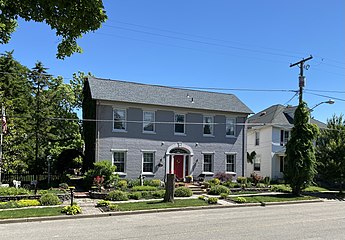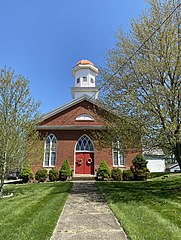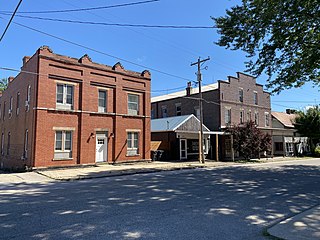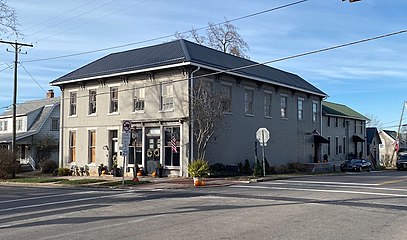
Rushville is a village in Fairfield County, Ohio, United States. The population was 302 at the 2010 census. Much of the village is listed on the National Register of Historic Places as the Rushville Historic District.

Benjamin Russell Hanby, also given as Benjamin Russel Hanby, was an American composer, educator, pastor, and abolitionist who wrote approximately 80 songs. The most famous are "Darling Nelly Gray" and the Christmas songs "Up on the House Top" and "Who Is He In Yonder Stall?".
Samuel Hannaford was an American architect based in Cincinnati, Ohio. Some of the best known landmarks in the city, such as Music Hall and City Hall, were of his design. The bulk of Hannaford's work was done locally, over 300 buildings, but his residential designs appear through New England to the Midwest and the South.
Africa is an unincorporated community located in Orange Township of southern Delaware County, Ohio, United States, by Alum Creek.

The Symmes Mission Chapel was a historic church building in the city of Fairfield, Ohio, United States. A simple structure constructed in the 1840s, it was named a historic site in the 1980s, but it is no longer standing.
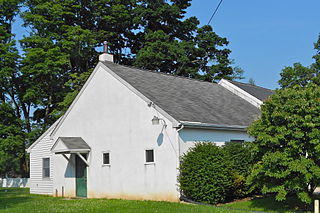
Ercildoun, population about 100, is an unincorporated community in East Fallowfield Township, Chester County, Pennsylvania, United States. The hamlet was founded by Quakers and was an early center of the abolitionist movement. In 1985 the entire hamlet, including 31 properties, was listed as a historic district on the National Register of Historic Places. Of these properties two were vacant land, 14 were significant buildings, ten were contributing buildings, and five buildings, built in the 1950s, were non-contributing. The Lukens Pierce House, an octagon house listed separately on the U.S. National Register of Historic Places, is located about half a mile northwest of the hamlet. Ercildoun is one of about ten hamlets in the township, which has no cities or towns, but has 31 sites listed on the National Register. It is one of the larger hamlets, located near the center of the township, and historically among the best known. The city of Coatesville is about 3 miles north.

The Wilton Center Historic District in the town center area of Wilton, Connecticut, was established as a town historic district in 1970 and was listed on the National Register of Historic Places in 1992.

The Madison Historic District is a historic district located in Madison, Indiana. In 2006, it was named a National Historic Landmark due to its unique Midwestern beauty and architecture scheme. Among the prominent buildings in the district are the Lanier Mansion, one of two buildings separately considered a National Historic Landmark in the district, and the Schofield House, the birthplace of the Grand Lodge of Indiana. In total, it comprises 133 blocks of Madison, Indiana, overlooking the Ohio River in Jefferson County, Indiana.

There are nine historic districts in Meridian, Mississippi. Each of these districts is listed on the National Register of Historic Places. One district, Meridian Downtown Historic District, is a combination of two older districts, Meridian Urban Center Historic District and Union Station Historic District. Many architectural styles are present in the districts, most from the late 19th century and early 20th century, including Queen Anne, Colonial Revival, Italianate, Art Deco, Late Victorian, and Bungalow.

Albert C. Nash (1825-1890) was an American architect best known for his work in Milwaukee and Cincinnati.

St. Michael's Catholic Church is a historic Catholic church in Mechanicsburg, a village in Champaign County, Ohio, United States. Completed in the 1880s, it served a group of Catholics who had already been meeting together for nearly thirty years. One of several historic churches in the village, it has been designated a historic site because of its well-preserved nineteenth-century architecture.

The Winegardner Village is an archaeological site near Rushville in Fairfield County, Ohio, United States.

The Northville Historic District is located in Northville, Michigan. It was designated a Michigan State Historic Site in 1970 and listed on the National Register of Historic Places in 1972. The district is roughly bounded by Cady Street, Rogers Street, and Randolph Street; alterations to the boundaries of the city-designated district in 2003 and 2007 included structures on the opposite sides of the original bounding streets within the district. The district is located in the heart of old Northville, and is primarily residential, although the 73 contributing structures, include several commercial buildings and a church. The majority of the district contains Gothic Revival houses constructed between 1860 and 1880.

The Perry County Courthouse is a historic government building in the city of New Lexington, Ohio, United States. Built near the end of the nineteenth century after the end of a county seat war, it is the fifth courthouse to serve Perry County, and it has been named a historic site because of its imposing architecture.

The Canaan Street Historic District encompasses the historic original town center of Canaan, New Hampshire. It is a basically linear district, running along Canaan Street roughly from Prospect Hill Road in the north to Moss Flower Lane in the south. The town flourished first as a stagecoach stop, and then as a resort colony in the late 19th century. The historic district was listed on the National Register of Historic Places in 1973. It included 60 contributing buildings.
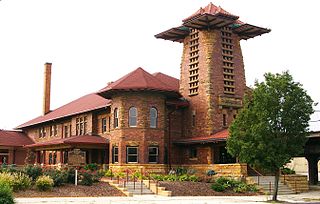
The Toledo and Ohio Central Railroad Station is a former railroad station located in Franklinton, by downtown Columbus, Ohio, known for its "whimsical and unusual" architecture. Built by the Toledo and Ohio Central Railroad in 1895, it served as a passenger station until 1930. It served as an office building for Volunteers of America from 1931 to 2003, and has served as a meeting hall for a firefighters' union since 2007. It was placed on the National Register of Historic Places in 1973.
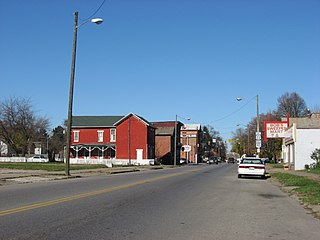
Putnam Historic District, located in Zanesville, Ohio, was an important center of Underground Railroad traffic and it home to a number of abolitionists. The district, with private residences and other key buildings important in the fight against slavery, lies between the Pennsylvania Central Railroad, Van Buren Street, and Muskingum River. It became a historic district of the National Register of Historic Places in 1975.

The historic Joseph Ijams House is located in the village of West Rushville Richland Township, Fairfield County Ohio at the intersection of Main and Broad streets. Built circa 1810, the house stands along the original Zane's Trace road constructed by Colonel Ebenezer Zane in 1797. It is constructed of brick on a raised sandstone foundation and sits prominently at the crossroads at the center of the village and is considered a fine example of early 19th century Federal style architecture. Long known locally as "The Old Tavern", the Ijams House served as an inn and waystation on the road from Zanesville to Lancaster. It is believed to be one of the last remaining examples in Fairfield County of the many taverns that once stood along this heavily travelled route. In the mid-19th century it was owned by Judge William McClung, a prominent Fairfield County jurist. It was added to the National Register of Historic Places in 1983.




